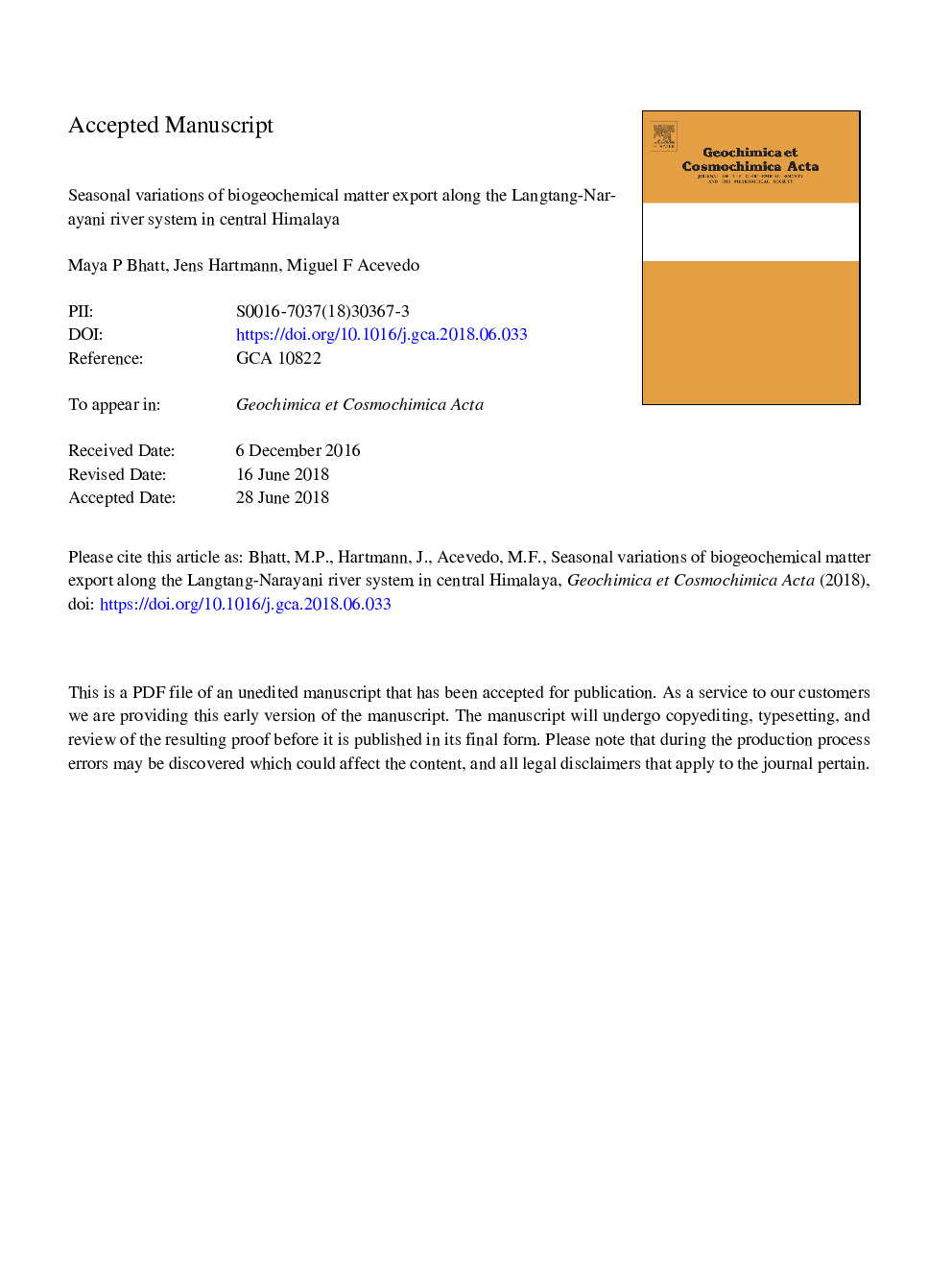| کد مقاله | کد نشریه | سال انتشار | مقاله انگلیسی | نسخه تمام متن |
|---|---|---|---|---|
| 8910598 | 1637919 | 2018 | 55 صفحه PDF | دانلود رایگان |
عنوان انگلیسی مقاله ISI
Seasonal variations of biogeochemical matter export along the Langtang-Narayani river system in central Himalaya
ترجمه فارسی عنوان
تغییرات فصلی صادرات ماده بیوگرافی و شیمی در امتداد سیستم رودخانه لنگتنگ-نارایانی در هیمالیا مرکزی
دانلود مقاله + سفارش ترجمه
دانلود مقاله ISI انگلیسی
رایگان برای ایرانیان
کلمات کلیدی
موضوعات مرتبط
مهندسی و علوم پایه
علوم زمین و سیارات
ژئوشیمی و پترولوژی
چکیده انگلیسی
Weathering and suspended matter fluxes of the Langtang Narayani river system in central Nepal Himalaya have been investigated at 16 stations for one year, based on monthly water sampling in the lower reaches and bi-monthly in higher elevation areas, to determine temporal variations of weathering fluxes along an elevation profile between 169 and 3989â¯m asl. Results indicate that the lower reaches are the dominant places of weathering in the system. The sum of major base cation fluxes is 2.9 to 9.2 higher during the monsoon season compared to the pre-monsoon season. Alkalinity and sea-salt corrected sulfate were the dominant anions (97%). The lowest downstream location exports 1611â¯tonsâ¯kmâ2â¯yrâ1 suspended sediment, 78.56â¯tonsâ¯kmâ2â¯yrâ1 of major cations (Naâ¯+â¯Kâ¯+â¯Mgâ¯+â¯Ca), 12.72â¯tonsâ¯kmâ2â¯yrâ1 of silica (4-fold higher than at the middle reaches of the basin), and 1.9â¯Ãâ¯106â¯molâ¯kmâ2â¯yrâ1 of dissolved inorganic carbon (8.9-fold higher than at the middle reaches). Nitrogen and phosphorus concentrations are low in general and dissolved organic carbon export is within expected ranges. River water pCO2 values are low in general, with exception of those main stem reaches where tributaries with relevant pyrite oxidation processes, and lower pH, alter the pattern locally. Element ratios suggest seasonal shifts in the weathering flux generation, modulated by the monsoon system. During the peak of the monsoon season the most relevant weathering products alkalinity, âSO4, âCa and âMg were not diluted, and increased concentrations observed at the lower reaches suggests an enhanced mobilization during this period of the year. Carbonate weathering exceeds silicate weathering along the drainage network and the carbonate- to silicate-cation mol ratio is 3.5 at the outlet. Sulfide oxidation probably enhances weathering rates besides the control of the soil-rock partial pressure of CO2. The ratio of the total alkalinity flux to sea-salt corrected sulfate equivalent flux at the base of the Himalaya at Narayanghat was 5.7. Sea-salt corrected sulfate equivalent export is about the same as the silicate cation-equivalent flux that leaves the system (98%). Therefore, further research on sulfur isotopes might be helpful to support the hypothesis that pyrite oxidation compensates for the idealized CO2-consumption by silicate weathering in the studied area.
ناشر
Database: Elsevier - ScienceDirect (ساینس دایرکت)
Journal: Geochimica et Cosmochimica Acta - Volume 238, 1 October 2018, Pages 208-234
Journal: Geochimica et Cosmochimica Acta - Volume 238, 1 October 2018, Pages 208-234
نویسندگان
Maya P. Bhatt, Jens Hartmann, Miguel F. Acevedo,
